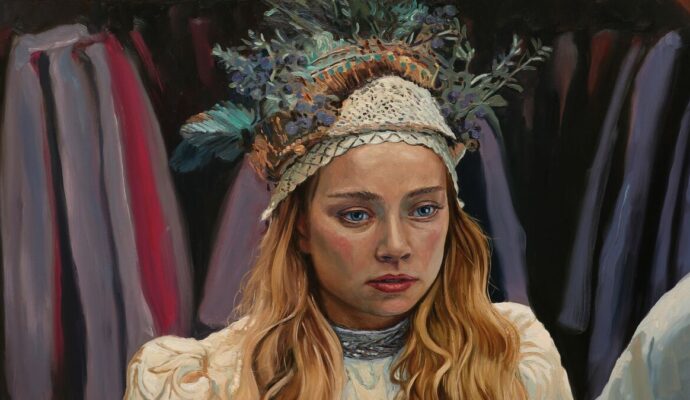Happy Birthday, Sally Hawkins! Yes, Ms. Hawkins turns 45 years young on April 27, and this talented thespian has several notable performances on her resume. Sally’s breakout turn in Mike Leigh’s “Happy-Go-Lucky” (2008) placed her on the cinematic map, and she garnered Oscar nominations for ‘Blue Jasmine’ (2013) and ‘The Shape of Water’ (2017) too.
Although The Academy fawned over work in Guillermo del Toro’s “Shape”, we think that she delivered an even better performance that year as real-life Canadian artist Maud Lewis in ‘Maudie’. Here is our review.
“Maudie” (2017) – “I’ll get a job or something.” – Maud Lewis
Maud (Sally Hawkins) is soft spoken, pleasant and kind, and for fun, she spends an occasional evening at a club, enjoying a drink and dancing by herself. One night at the aforementioned club, she soaks up laughter and music but without socializing or speaking to anyone. Maud fills her time that evening surrounded by people, smiles and feels content, but she is terribly isolated in the crowd.
She lives rent-free at her Aunt Ida’s (Gabrielle Rose) home, and on one occasion, Maud’s brother, Charles (Zachary Bennett), stops by and badgers his sister by saying that she cannot take care of herself. In her 30s, Maud suffers from rheumatoid arthritis and has never been on her own, so this moment strikes her as an opportunity to hit the pavement, find a job and move out. She does so in all three cases, when a local fisherman, Everett (Ethan Hawke), hires her as his housemate, to clean and cook in his very modest home, just down the road in Marshalltown, Nova Scotia.
What is a housemate? What are Everett’s conditions? What are the living arrangements? This job carries very muddy boundaries, but eventually, Maud’s purpose becomes crystal clear in the most surprising way.
Director Aisling Walsh fulfills her crystal clear vision of Maud Lewis’ biopic. A biopic about a sweet, immensely determined and talented artist. Maud and her paintings left a lasting legacy, and Walsh recreates the harsh conditions in which this artist lived. Certainly, the wind, snow and biting cold can be unforgiving in this Canadian coastal providence, but difficult weather is only one element of her hardships. The picture begins while Maud is an adult, but Hawkins drops many reveals that her character’s past has been littered with emotional and physical abuse. For instance, while walking with Everett, Maud casually mentions that a group of kids threw rocks at her on the way to his house, as if the pelting that she endured was simply routine.
During another scene with Everett, Maud confidently responds to comments of her limp and irregular movements – from the arthritis – by saying, “I was born funny.”
Hawkins delivers the line to Hawke’s Everett with deep resonance, as if Maud has repeated this announcement for decades – to hundreds of people – in order to explain why she finds trouble walking. These moments become terribly effective in painting the historical adversity of Maud’s grueling physical affliction, during a time and place when sympathy is rarely found.
Not only does Maud clue the audience into her arduous past, but her relationship with Everett – a simple man who appears to only know corrosive anger and blunt insults as his only mode of communication – is brutal and abusive. Everett most likely left his sensitivity at the door of the orphanage in which he grew up, and can be best described as a caveman sending showers of thoughtless decrees in Maud’s direction.
Everett wishes for a wife, so – early in the film – he places an advertisement for a “housemate” in a general store as an awkward, 1930s/1940s version of a 21st century dating site. Maud is not who Everett envisioned as his “housemate”, so she becomes an easy target.
Hawke persuasively portrays this ogre in black and white terms from the start, but over the course of the picture, he slowly slips in Everett’s softer humanity towards Maud in unexpected ways. He succeeds in this challenging acting task, as Everett’s behavior to this sensitive soul shifts, but not before our heart goes out to Maud, a woman without options.
Thankfully, Hawkins – who has plenty of acting options – decided to play Maud, and she is extraordinary here. She is entirely convincing as a fragile woman who has received emotional (and sometimes physical) scorn from kids, townsfolk and her own family due to her physical limitations. In the film, Everett is just about the only person – that the audience sees – delivering mean-spirited words in her direction, but Hawkins carries – in her face, in her movements and in her spirit – the decades of toil that Maud endured off-camera. In one on-camera instance, Everett tells Maud that his dog and chickens are more important than her, and she begrudgingly accepts these harsh words as business as usual, as her off-camera years of abuse have built up her scars.
Therefore, when Maud turns to art as a cathartic outlet from her depressing, bleak environment, her escape into paint becomes a lift of epic proportions for the viewer. For Maud, painting makes her happy, and her lovely, adorable paintings of birds, cats, trees, blue skies, and more reflect how she sees the world, despite the cold, cruel existence that we see. Hawkins delivers all of this, and her work here absolutely deserves an Oscar nomination in a deeply affecting, unforgettable performance. Beautiful and heartfelt.
The movie runs nearly two hours, and Walsh carries us to some dark places, but with the excellent lead performances, a grounded tone and a gentle, moving soundtrack, the picture never loses our attention, especially as we try to embrace Maud’s spirit.
Maud simply viewed the world in a different light than most of us, but Walsh and Hawkins do not offer a secret decoder ring to unlock her secret to success. We receive no answers but do experience massive inspiration, joy and tears.
⭐⭐⭐ 1/2 out of ⭐⭐⭐⭐
Image and Trailer credits: Sony Pictures Classics




